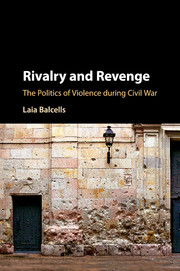Book contents
- Frontmatter
- Dedication
- Contents
- List of Figures
- Acknowledgments
- Conventions
- Preface
- PART I
- PART II
- 3 History of the Spanish Civil War (1936–1939)
- 4 Executions and Massacres During the Spanish Civil War
- 5 Bombardments During the Spanish Civil War
- PART III
- Appendix
- Bibliography
- Index
- Miscellaneous Endmatter
4 - Executions and Massacres During the Spanish Civil War
from PART II
Published online by Cambridge University Press: 18 May 2017
- Frontmatter
- Dedication
- Contents
- List of Figures
- Acknowledgments
- Conventions
- Preface
- PART I
- PART II
- 3 History of the Spanish Civil War (1936–1939)
- 4 Executions and Massacres During the Spanish Civil War
- 5 Bombardments During the Spanish Civil War
- PART III
- Appendix
- Bibliography
- Index
- Miscellaneous Endmatter
Summary
DIRECT VIOLENCE IN INITIAL PERIODS OF THE SPANISH CIVIL WAR
In this chapter, I dig into the determinants of direct violence against civilians (i.e., executions and massacres) during the Spanish Civil War, and I test the main hypotheses derived from the theoretical framework presented in Chapter 2. As in the case of any other armed conflict, we have very little first-hand information on the motives of the perpetrators of violence against civilians (Solé i Sabaté and Villarroya 1989: 70), as well as the motives of those who were key collaborators in the perpetration of this violence. There is no first-hand knowledge of their motives because they rarely made them explicit; in addition, they tried to avoid showing responsibility for these events. As Térmens writes, “Those who promoted the repression of political enemies knew that they could not make their claim public and they were worried about showing their responsibility for these events, in case the situation changed in the future” (1991: 76). Yet, guided by the theory, we can infer motives from regularities and patterns found in the data.
There is plenty of qualitative evidence from the Spanish Civil War supporting the claim that direct violence was the result of armed organizations systematically targeting their political enemies. Even if it was not always the case that those executed were affiliated with political parties or trade unions, it is certainly true that people with those affiliations were much more often targeted than other citizens. For example, in the region of Teruel, 80.23 percent of the victims of direct violence were right-wing sympathizers or members of right-wing political parties (Casanova 2007); in the city of Teruel, a vast majority of the victims of leftist violence were members of right-wing parties (Martín Rubio 1987). According to a civil war testimony, Díaz-Plaja, people were targeted in rearguard territories for political ideas “that had been expressed in the years preceding the military coup. This is something that was sometimes hard to discern in big cities, but it was known to everyone in villages” (1994: 113).
- Type
- Chapter
- Information
- Rivalry and RevengeThe Politics of Violence during Civil War, pp. 87 - 129Publisher: Cambridge University PressPrint publication year: 2017



